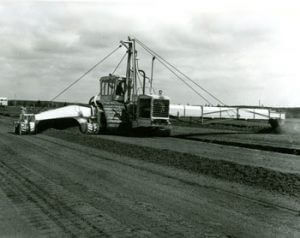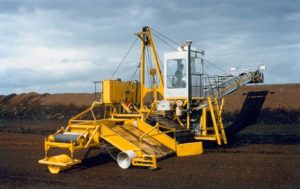Harvester
Type – III
 The purpose of this machine is to harvest milled peat from the bog fields in exactly the same way as the Type II harvester attachment on the HD. Tractor.
The purpose of this machine is to harvest milled peat from the bog fields in exactly the same way as the Type II harvester attachment on the HD. Tractor.
The tractor is full track unit comprising a lightly constructed mainframe mounted on caterpillar type tracks; on one side of the tracks return at a high level to accept the harvesting attachment. The track chain is the cast link type running on cast sprockets and intermediate rollers. It is powered by a diesel engine and the transmission consists of a primary gearbox of special design, with a power take off shaft, and increasing the transmission RPM, through a standard automobile change speed gearbox and standard agricultural tractor transmission unit. The final drive reduction between rear transmission half shaft and track sprocket is by special spur gear reduction box.
The tractor is steered by a clutch and brake system of proprietary manufacture which is built into the rear transmission unit. A driver’s cab of generous proportions is fitted, with sliding doorand safety glass panels all round. Some of these cabs are of fibre-glass construction and others of steel.
The attachment consists of a single or double spiral unit and a single belt conveyor, articulated at two points.

The spiral unit is a steel sheet casing suitably stiffened with standard steel sections, capable of housing one or two spirals. The front and rear, of the casing are open. The peat ridge is allowed to enter on the front side, as the machine advances, while the rear opening is blanked off by a trailing board which is raised and lowered in guides as required, and when in the lowered position, free to move in these guides as the surface of the bog demands. The spiral or spirals are supported in this rigid casing, by a bearing at each end of the shaft. The revolving spiral or spirals convey the peat along the bog surface and trailing board and up a sloping plate of the casing, discharging it onto the belt conveyor.
The spiral unit is supported on two inner and two outer rollers, each pair are arranged so that each roller is free to follow the surface of the bog while carrying its share of the load.
 The drive to the spiral or spirals is by double universally-jointed propeller shaft and the casing is pin jointed to a structural frame which in turn is pin jointed to the tractor unit allowing complete flexibility of the spiral unit to follow the contour of the bog.
The drive to the spiral or spirals is by double universally-jointed propeller shaft and the casing is pin jointed to a structural frame which in turn is pin jointed to the tractor unit allowing complete flexibility of the spiral unit to follow the contour of the bog.
The belt conveyor is partly constructed on the structural framework connecting the spiral unit and tractor unit, including the conveyor drive pulley, and partly on the tractor unit and the remainder forms the jib, projecting from the machine. While flat carrying idlers are used for the receiving end of the belt, flexible shaft type troughing idlers are used over the articulated portion and conventional type troughing idlers on the jib. At the discharge end of the jib a moveable deflector is fitted to control the trajectory of the peat.
The attachment is carried on the tractor unit and a mast on the tractor unit is braced back to the spiral casing by a wire rope, while a multiple rope system actuated by a hydraulic ram on the mast is passed over the top of the mast and connected to the projecting conveyor jib. The top of the mast is also controlled relative to the tractor unit by wire rope and hydraulic ram.
The driver of the machine can raise or lower the jib and the trailing boards, and raise the spiral casing completely off the bog surface by hydraulics, and control the jib deflector by a simple rope winch.